The Road to Glory

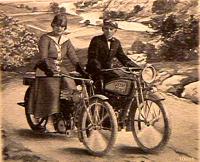
In the early 1900's motorcycles were just evolving beyond bicycles with engines attached to them. They were ridden by a daring few people over the paths, trails, and rough, unpaved roads of the time. A few decades latter, they were sophisticated machines engineered specifically for their purpose, ridden by thousands of people of all ages, incomes, and backgrounds; commercial and civil employees; and members of the military.
The story of the Excelsior-Henderson brand begins in 1876 with the founding of the Excelsior Supply Company, a maker of bicycles and parts. During the latter half of the 1800's bicycles had become very popular and were an important economical way of transportation.
Bicycles were significant forerunners of motorcyles in the ways bicyclist used them, the characteristics they demanded in them, and the culture they formed around them. People commuted, toured, and raced on bicycles. Some folks used bicycles in their work, while others rode for pleasure and good health. This popularity created fierce competition among manufacturers, leading them to continually improve performance, reliability, comfort, and appearance. All of these aspects of bicyclists and bicycles defined the original context of motorcyclists and motorcycles.
While bicycle manufacturers improved their products, others developed powered versions and new types of engines. About ten years before the Excelsior Supply Company was founded, two independent developers created powered two-wheeled vehicles by adding a steam engine to a prototypical bicycle called a Velocipede. In 1876, a 4-stroke internal combustion engine was developed in Germany. Two years latter a 2-stroke version of the engine appeared.
In 1885, a German developer built a gas powered, wooden, belt-drive two-wheeler. It was the first powered two-wheeled vehicle with equal-sized wheels and the engine between the wheels and is considered by many to be the first motorcycle.
By the end of the 19th century, bicycling was the sport in the United States. Top racers, sponsored by the major manufacturers, were common household names. On the streets, the culture of bicycling included bicycle rallies, group rides, hillclimb, street racing--exactly what the culture of motorcycling would become in the future years.
The earliest motorcycles had the same traits as bicycles--they were strong, light, durable, and economical--and were used in the same applications. They were faster than bicycles and advertised as a way to ride without the work. These early motorcycles used a standard or strengthened diamond-shaped bicycle frame, an engine, and the necessary belts or chains to transfer the engine's power to the front or rear wheels.
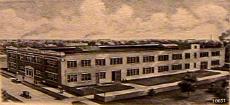
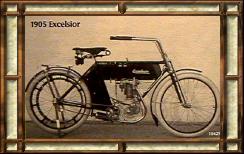 In 1905, Excelsior crafted its first motorcycle at 233, 234, 237 Randolph street, Chicago, Illinois. It was a single-speed machine, featuring a single-cylinder, 21 cu. in. "F-head" engine, in which the intake valve was on top of the cylinder and the exhaust valve was inverted inside the cylinder. The frame was a keystone type, with the crankcase an internal frame component. Dual top frame tubes sandwiched the fuel tank, a feature quickly copied by other manufacturers. With a flat, leather belt transferring power to the rear wheel, and a leading-link front suspension to swallow the bumps, riders could speed along at 35 to 40 mph.
In 1905, Excelsior crafted its first motorcycle at 233, 234, 237 Randolph street, Chicago, Illinois. It was a single-speed machine, featuring a single-cylinder, 21 cu. in. "F-head" engine, in which the intake valve was on top of the cylinder and the exhaust valve was inverted inside the cylinder. The frame was a keystone type, with the crankcase an internal frame component. Dual top frame tubes sandwiched the fuel tank, a feature quickly copied by other manufacturers. With a flat, leather belt transferring power to the rear wheel, and a leading-link front suspension to swallow the bumps, riders could speed along at 35 to 40 mph.
By 1906, motorcycles had evolved to using spring frames, magneto ignitions, and spring-mounted seats. Bicycle frames, wheels, and tires had been replaced by sturdier versions. Excelsior offered its first two-cylinder model, with a 61 cu. in. (1000 cc) engine, in 1910. Like the 30.50 cu. in. single-cylinder model, the two cylinder Excelsior Autocycle Models F and G were single-speed, but they had a heavier frame. The single-cylinder model was discontinued in 1913.

Excelsior gained popularity in its first years, as motorcycling clubs formed and held competitions. Early motorcycle races were held on flat dirt tracks of various lengths, on board tracks, and across long distance courses between cities or national borders. The board tracks, or motordromes, were high-banked ovals with a wood surface of two-inch wide planks. Similar to the bicycle racing velodromes, board tracks were renowned for treacherous racing and huge splinters. Depending on the type of competition, riders raced against each other, against the clock, or for top speed over a given distance. With competition riders on the payroll, manufacturers used racing and hillclimbing to get their names in front of spectators who were also potential customers, and to test new designs under the grueling stresses of competition. The designs and modifications that succeeded in competition often appeared on later road models in one form or another.
When Excelsior began conpeting, motorcycle racing was a popular sport. Excelsior quickly became a serious challenge to other industry competitors. At Chicago's 1/3 mile Riverview Motordrome, Excelsior rider Joe Wolters was almost unbeatable in 1911. In August, he set an unofficial two-mile world record, making the six laps in 1 minute, 22.2/5 seconds, with a speed of 88.9 mph. At the track that same month, Wolters set a new one-mile record with a time of 40 1/5 seconds, a speed of 88.9 mph. In September, Excelsior rider Jake DeRosier set an unofficial world record for the kilometer of 94 1/5 mph. Wolter's and DeRoiser's exploits increased motorcycle enthusiast's interest in the Excelsior brand and drew attention from the industry's top competitors.
At Chicago's 1/3 mile Riverview Motordrome, Excelsior rider Joe Wolters was almost unbeatable in 1911. In August, he set an unofficial two-mile world record, making the six laps in 1 minute, 22.2/5 seconds, with a speed of 88.9 mph. At the track that same month, Wolters set a new one-mile record with a time of 40 1/5 seconds, a speed of 88.9 mph. In September, Excelsior rider Jake DeRosier set an unofficial world record for the kilometer of 94 1/5 mph. Wolter's and DeRoiser's exploits increased motorcycle enthusiast's interest in the Excelsior brand and drew attention from the industry's top competitors.
In 1911, Chicago-based Schwinn Company entered the motorcycle industry and purchased their neighboring Excelsior.
Original corporate documents at the American Motorcycle Association museum show that Schwinn contracted to purchase Excelsior on November, 14th, 1911. Schwinn agreed to purchase all assets of the Excelsior Supply Company and the Excelsior
Motor and Manufacturing Company, including: manufactured and in-process motorcycles, bicycles, and motors; factory and office equipment; tools; all parts and stock; good will; and all rights, including the company's patents and names; and the privileges of manufacting and sales. With motorcycles gaining acceptance as a mode of transportation, and with Schwinn's experience building frames for two-wheelers, Excelsior was a logical addition to this successful bicycle manufacturing company.
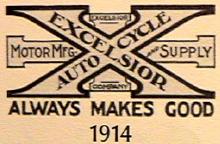

On Febuary 1, 1912, Schwinn concluded the purchase of Excelsior for the price of $500,000 and moved the factory to 2246 Union Ave, Chicago, Illinois, where it remained until 1914. They immediately advertised the new Excelsior aggressively and added it to the offerings of some of the franchisees in their extensive dealer organization. A 1912 advertisement for Excelsior announced a lower price due to increased factory output and improved economies. The motorcycle was touted for its comfort, speed, durability, and economy. Easy riding and steady handling due to its long wheel base and low center of gravity was also advertised.
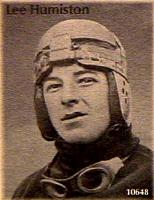 On December 30, 1912, Excelsior gained renowned for being the first motorcycle to officially reach 100 mph. On that day, at the one-mile board track in Playa del Ray, California, Excelsior rider Lee Humiston "turned a ton" becoming the first motorcyclist officially timed at 100 mph by a sanctioning organization. At the same track a few days later, on January 7, 1913 Humiston took every time record for the distance between 2 and 100 miles, breaking the previous 100 mile record of 75 minutes, 24-2/5 seconds with his time of 68 minutes, 1-4/5 seconds.
On December 30, 1912, Excelsior gained renowned for being the first motorcycle to officially reach 100 mph. On that day, at the one-mile board track in Playa del Ray, California, Excelsior rider Lee Humiston "turned a ton" becoming the first motorcyclist officially timed at 100 mph by a sanctioning organization. At the same track a few days later, on January 7, 1913 Humiston took every time record for the distance between 2 and 100 miles, breaking the previous 100 mile record of 75 minutes, 24-2/5 seconds with his time of 68 minutes, 1-4/5 seconds.
Also that year, in Detroit, Michigan, the Henderson Company began manufacturing its in-line four cylinder Henderson motorcycle. The Henderson Company made a motorcycle for those who wanted more than a motorized bicycle and developed a premium-quality machine with a distinquished appearance.
The Vise President and principal designer of the Henderson Company, William (Will) Henderson, had a desire to build motorcycles from the time he was a boy. He worked for nearly eighteen years in the motorcar business as a designer and draftsman. His Father--Vise President of the successful Winton Motors, an automobile manufacturer with a reputation for building fine products--repeatedly tried to discourage his son, not believing there was any future in motorcycles. But Will would not be thwarted, and time and again presented his father with plans for a motorcycle, plans he worked on at night, after a full day at work.
Finally, Will came to his father with a fully-detailed design for a four-cylinder motorcycle. Will's father, concerned about the effect on his son's health of many sleepless nights spent designing, convinced Will to give up his job and advanced him money to create a prototype. His father hoped his son would give up the project when faced with the practical difficulties of building the prototype, instead, Will pursued his task with a relentless passion and, in late 1911, the Henderson Company began advertising its first model, the 1912 Henderson. At age 28, Will had been working on motorcycle designs for about nine years.
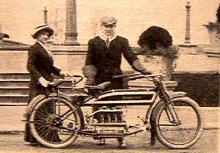
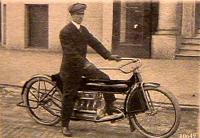 The 1912 Henderson an unusual motorcycle for the time. It was a single-speed machine, with a clutch and no gearbox. The engine was an automobile-like 58.9 cu. in. (965cc) four-cylinder, featuring four individually-cast cylinders of the F-head design. Because the four-cylinder engine delivered relatively constant power strokes, the 1912 model was designed with a chain drive instead of a belt. The engine was started with a folding hand crank, eliminating the pedals and the complex procedure required to start most other motorcycles made in the United States. The frame was elongated, extending about two feet past the front of the engine, with the front down tube curved in the same arc as the front fender. A rubber-coated floorboard was mounted to the lower horizonal frame members in the space in front of the engine. Automotive-type pedals, on either side at the front of the footboard, controlled the bicycle-style rear coaster brake.
The 1912 Henderson an unusual motorcycle for the time. It was a single-speed machine, with a clutch and no gearbox. The engine was an automobile-like 58.9 cu. in. (965cc) four-cylinder, featuring four individually-cast cylinders of the F-head design. Because the four-cylinder engine delivered relatively constant power strokes, the 1912 model was designed with a chain drive instead of a belt. The engine was started with a folding hand crank, eliminating the pedals and the complex procedure required to start most other motorcycles made in the United States. The frame was elongated, extending about two feet past the front of the engine, with the front down tube curved in the same arc as the front fender. A rubber-coated floorboard was mounted to the lower horizonal frame members in the space in front of the engine. Automotive-type pedals, on either side at the front of the footboard, controlled the bicycle-style rear coaster brake.
The finish was black with gold pinstripes; the fenders had red pinstripes; and the unique, round-ended, cylindrical fuel tank had red V-shaped panels at either end. The passenger, or tandem, saddle was located in front of the operator's saddle, and footpegs extended from the front fork for the passenger's feet. The Henderson was advertised for its mechanical advantages and low center of gravity, its quiet and vibrationless ride, its roonmy footboard in front of the engine, and its easy hand-crank starting method.
The Henderson did well in its first year of production, gaining acclaim from riders and dealers alike, particularly because its four-cylinder engine gave it extraordinary performance in mud, sand, and in climbing steep hills. The 1912 Hendersons were first built in an assembly plant running two shifts, and with a significant amount of the manufacturing jobbed out. In June, Henderson production was moved to a new manufacturing plant designed to produce 25 motorcycles per day. July 27, 1912, was declared a "Henderson Red Letter Day," as the company received over 100 orders that day from dealers around the country. Henderson was already exporting its product around the world to countries such as England, Austrailia, Argentina, and Japan.
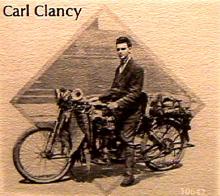
Return to Top
1913
In 1913, Excelsoir sold exsisting inventory, but stopped manufacturing the single-cylinder model. The two-cylinder model used an all-chain drive and remained a single-gear machine. Excelsior was advertised as the only motorcycle with "complete control in the handlebars," with the right hand grip controlling the throttle and the left the clutch. Advertisements also emphasized the comfortable ride afforded by the saddle mounted on the "Kumfort Kushion" seat post and the cradle spring front forks.
 Excelsior racing great Bob Perry began his racing career in 1913. He rode a 1913 model to win the prestigious 300 mile Grand Prix road race held on a 11-1/2 mile curcuit in Savannah, Georgia.
Excelsior racing great Bob Perry began his racing career in 1913. He rode a 1913 model to win the prestigious 300 mile Grand Prix road race held on a 11-1/2 mile curcuit in Savannah, Georgia.
Meanwhile, Henderson's 1913 model changed considerably from the previous year's model. The engine displacement was increased to 64.9 cubic inches (1064 cc). The top frame tube now sloped down near its intersection with the seat mast, resulting in a lower saddle height. The bicycle-style rear coaster brake was replaced by a band brake manufacured by Henderson. The fork and frame were strengthened, and the slab-sided fuel tank tapered toward the rear to accommodate the sloped top frame tube. The forward-tandem saddle was replaced by a rear-mounted version, a Henderson made accessory. The 1913 Henderson was now dark blue with gold pinstripes and had a gray fuel tank with dark blue panels bordered with gold pinstripes.
A touring machine, the Henderson did not figure in track racing or hillclimbing at first. However, it was a record-setting long distance and endurance competitor right from the start. In 1913, Carl Clancy, on his 1912 Henderson Four, became the first motorcyclist to circle the world, putting over 18,000 miles on his machine.
Part two--1914 thru 1917-- The Glory Continues